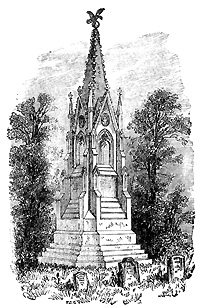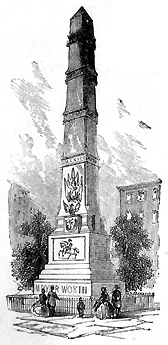|
|
Chapter IV
New York As It Is.
The Libraries, Monuments and Markets of New York A. Description of the Island.—
B. Population at Different Periods.—
C. Streets and Avenues.—
D. Architecture of Manhattan—
E. Business in New York—
F. Churches of New York—
G. Parks and Squares.—
H. How New York is Supplied with Water.—
I. The Schools and Colleges of New York.—
J. Public Security—
K. New York All the Year Round—
L. The Libraries, Monuments and Markets of New York—
M. The Cemeteries of New York.
The Monuments
The Libraries—
The Monuments—
The Markets.
Some portions of New York and vicinity are thickly studded with monuments, commemorating the names and deeds of the great, the patriotic, or the admired. Some reared by private enterprise over the remains of friends have cost large fortunes, and money which might have blessed the world has, in more than one instance, been foolishly thrown away. Some very laudable efforts in this line have, however, been undertaken. Churches have reared chaste monuments in memory of devoted pastors, students to eminent men of letters, and soldiers to attest their respect for fallen comrades. The soldiers' monument, which lifts its modest head on the western elevation of Greenwood cemetery, and the one erected by the Seventh regiment in Central Park, are very imposing testimonials of patriotic regard. The beautiful monument of Columbus, the peerless navigator, and that of the learned Humboldt, and one of Shakspeare, all recently placed in Central Park, are worthy of mention. Old Trinity church-yard contains several, the most important of which is— THE MARTYRS' MONUMENT, erected by the Trinity corporation in 1852, to the memory of those patriots who died in the old Sugar House and in other prisons during the Revolution. It is a chaste Gothic structure of brown stone, standing on a granite foundation, about forty-five feet high, appropriately inscribed, and crowned with the American eagle. THE WORTH MONUMENT, erected on the west side of Madison square by the corporation of the city of New York in 1857, is the only one completed at the public expense. The monument is a four-sided chaste granite obelisk; its sides, besides presenting the equestrian image in high relief, are nearly covered with inscriptions, setting forth the career of the hero of Cherubusco and Chapultepec. Handsome bronze reliefs are introduced between the several inscriptions.  Washington Monument (Union square and Fourteenth street.) THE WASHINGTON MONUMENT stands at the south-east portion of Union square, and is a colossal bronze equestrian statue, executed with great artistic skill by Browne [sic], and was erected through the laudable efforts of Colonel Lee. The figure is fourteen and one-half feet high, and stands upon an immense granite pedestal of the same height, making the whole twenty-nine feet. This representation of the Father of his country has been universally admired. The means for its erection were contributed by the inhabitants of the neighborhood. It is said that the gentlemen who circulated the subscription called one day on a property-owner, noted alike for his wealth and avarice. The subject being presented, the miser stated that he could give nothing, and remarked that no monument was necessary. Laying his hand upon his breast he exclaimed, with emphasis, "I keep the Father of his country here." "Well," responded the intrepid collector, "if the Father of his country is there, he is in the tightest place he ever found."
THE LINCOLN MONUMENT, erected in September, 1870, by the Union League Club, stands at the south-west corner of Union square, and corresponds in position with the Washington monument on the opposite corner. The pedestal consists of three Dix Island granite stones, which weigh in all over forty tons, and is twenty-four feet high. The statue, which represents the deceased statesman in citizen's dress, but covered with a Roman toga, is of bronze, nearly eleven feet high, and weighs three thousand pounds. The design was formed by H. K. Brown, Esq., and is a faithful representation of the martyred President. In his left hand he holds the Proclamation of Emancipation, and a galaxy of stars on the pedestal represent the States of the Union. THE VANDERBILT MONUMENT, erected in 1869, and crowning the western wall of the immense freight depot which covers the old St. John's Park, is by far the most elaborate and costly undertaking of its kind on Manhattan. It was conceived, and carried forward to completion, mainly through the untiring exertions of Captain Albert De Groot. The whole scene in bronze is one hundred and fifty feet long, and over thirty feet high, with admirable groupings of ancient and modern representations, and is designed to allegorically exhibit the brilliant and successful career of the dashing Commodore. The central and chief figure is the Railroad King, a life-like and correct statue, twelve feet high, weighing over four tons. On the left of this central figure everything is seafaring, representing his early beginnings on the New York Bay, his later travels, and his patriotic munificence. In the distance Neptune in bold relief is seen, in a half-reclining posture, looking seaward, while a schooner, a steamer, a steamship, and miscellaneous aquatic groupings, complete the center of the picture. On the right terra firma, the theater for a king of railroads, spreads away. At the extreme right, corresponding to Neptune, stands the figure of Liberty, while the intermediate space exhibits forests, cultivated fields, railroad track with tools, tunnels, switchmen, and dashing trains. The whole weighs over fifty tons, and cost half a million dollars, which was contributed by New York bankers and capitalists. It is an appropriate recognition of the perseverance and thrift of a modern Knickerbocker, who, without patrimony or schools, has carved out his own diploma, and compelled the world to sign it. | ||
|
119
:: Previous Page :: Next Page ::
Books & articles appearing here are modified adaptations
from a private collection of vintage books & magazines. Reproduction of these pages is prohibited without written permission. © Laurel O’Donnell, 1996-2006.
|
|||




